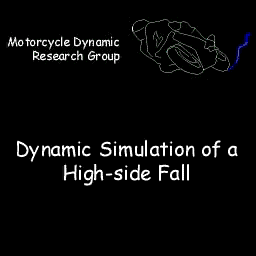 |
Vittore Cossalter |
 |
Vittore Cossalter |
There is a maxim that expresses an inexorable truth: "there are riders who have fallen and riders that they will fall." Great truth, which rider can say to be never fallen?
Assen, 2013: great victory of Valentino but how many terrible falls for high-side.
What is the high-side? Let's try to provide an explanation scientifically correct.
"High-side" fall due to rear braking
The example shows the simulation of a ?high-side? fall, which is closely related to vehicle stability and the interdependence between lateral and longitudinal tyre forces.
Frame l In a curve the rider starts to brake the rear wheel, therefore the longitudinal braking force increases, as does the total friction force;
Frame 2 The total friction force reaches the limit value, the rear wheel loses grip and the rear of the motorcycle moves outward;
Frame 3 The rider makes a mistake, reducing the braking force suddenly, and the rear wheel takes grip again;
Frame 4 The large side slip, which is still present, generates a lateral force impulse; the impulse torque around the centre of mass produced by the lateral force is not balanced by the torque caused by the tire load;
Frame 5 The result is that the motorcycle is violently twisted and pushed upwards.
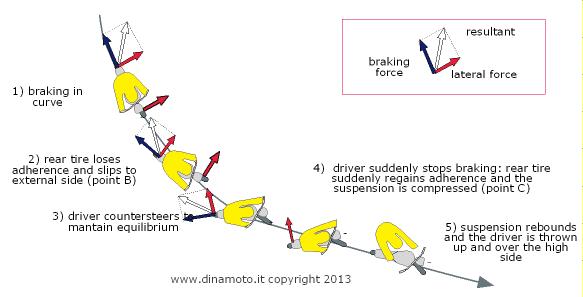
Tire behaviour during a "high-side" may be better understood by looking at the following figure, which shows the available lateral tyre force when a longitudinal tyre force is present.
In both figures, the envelope of the families of curves is the friction ellipse.

| The parameter of the curves is the longitudinal slip k Fx = longitudinal force Fy = lateral force Fz = vertical load |
The parameter of the curves is the side slip angle l |

The impulse torque around the centre of mass, produced by the lateral force, is not balanced by the torque caused by tyre load, , consequently the rider falls.
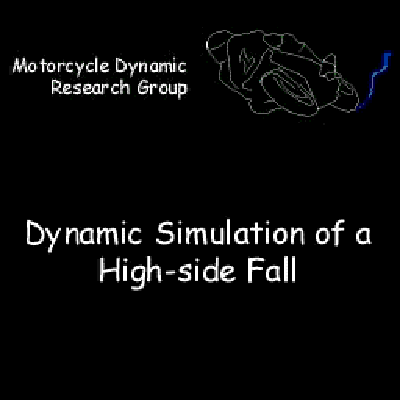
"High-side" fall of a motorcycle during thrusting
This example shows the simulation of a "high-side" fall, due to the driving force.
Frame l In a curve the rider starts to thrust the rear wheel, therefore the longitudinal driving force increases, as does the total friction force;
Frame 2 The total friction force reaches the limit value, the rear wheel loses grip and the rear of the motorcycle moves outward;
Frame 3 The rider makes a mistake, reducing the thrusting force suddenly, and the rear wheel takes grip again;
Frame 4 The large side slip, which is still present, generates a lateral force impulse; the impulse torque around the centre of mass produced by the lateral force is not balanced by the torque caused by tyre load;
Frame 5 The result is that the motorcycle is violently twisted and pushed upwards.
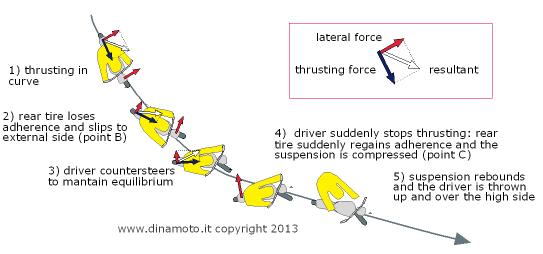
Tire behaviour during a "high-side" may be better understood by looking at the following figure, which shows the available lateral tyre force when a longitudinal driving tyre force is present.
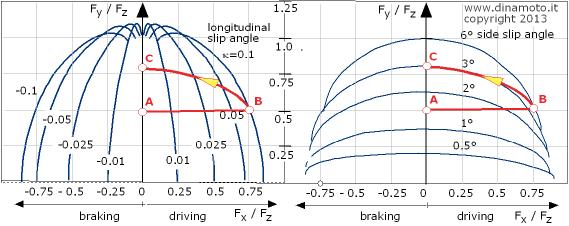
| The parameter of the curves is the longitudinal slip k Fx = longitudinal force Fy = lateral force Fz = vertical load |
The parameter of the curves is the side slip angle l |
In both figures, the envelope of the families of curves is the friction ellipse.

The impulse torque around the centre of mass, produced by the lateral force, is not balanced by the torque caused by tyre load, , consequently the motorcycle falls.
